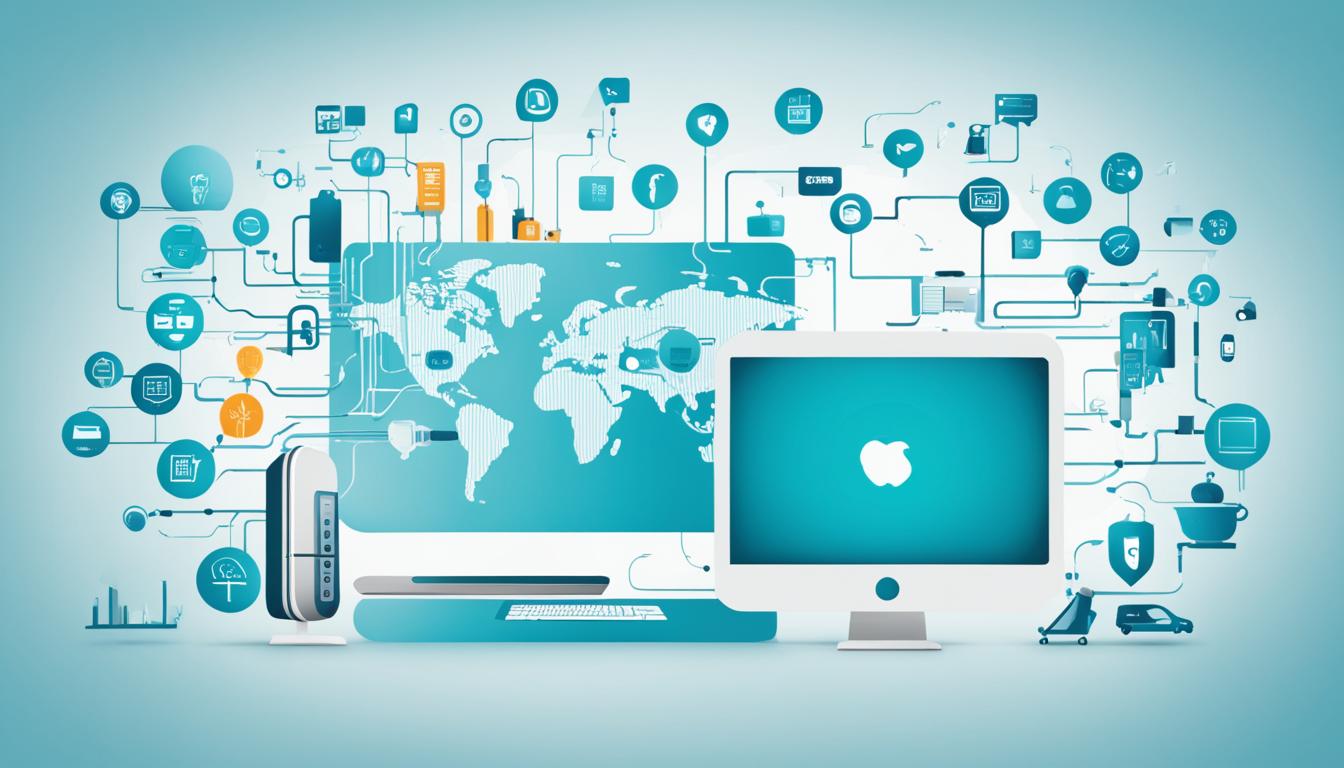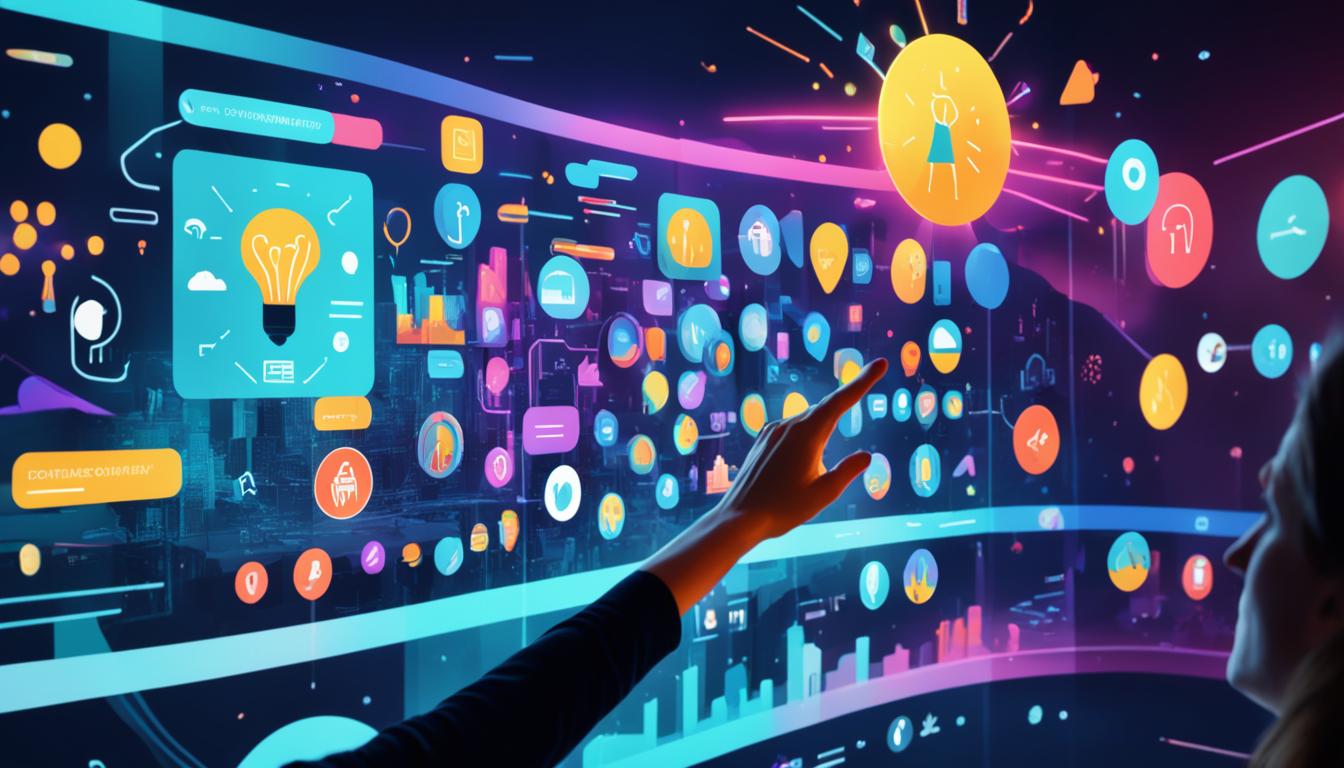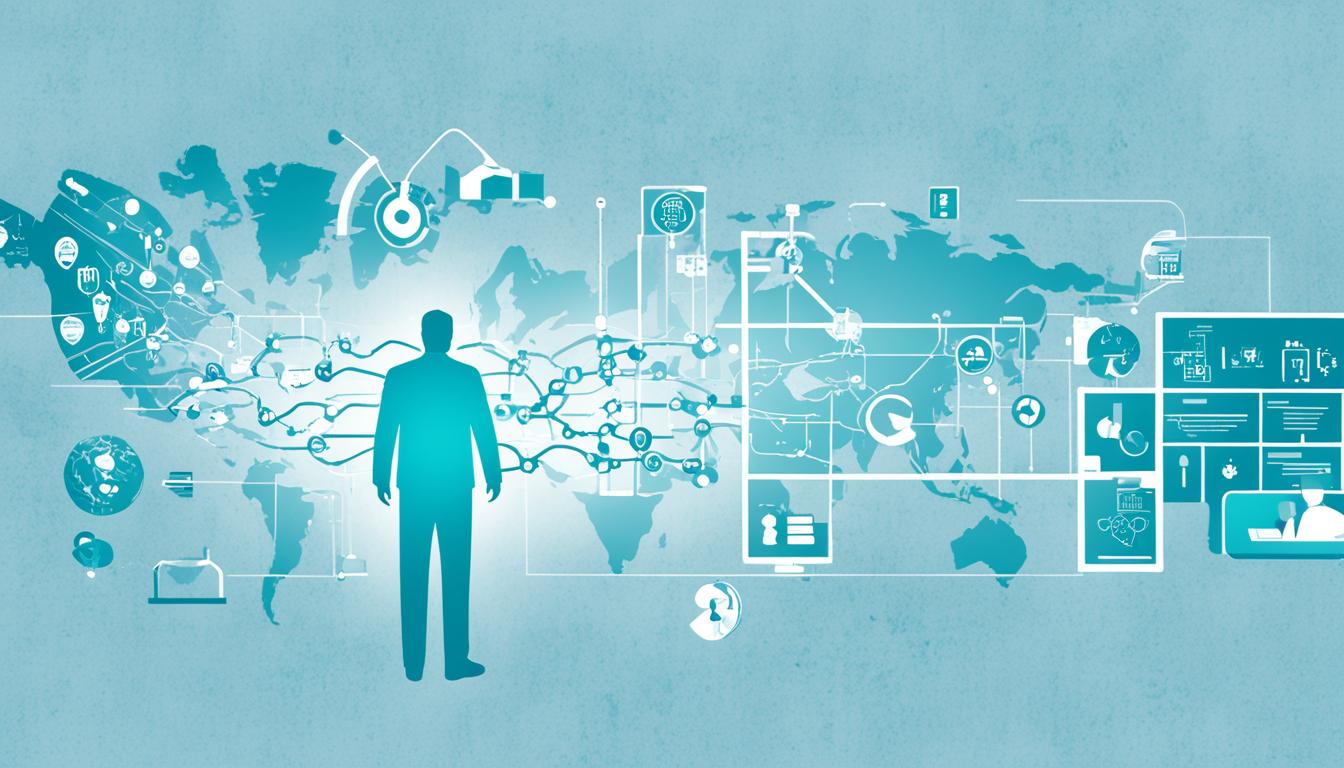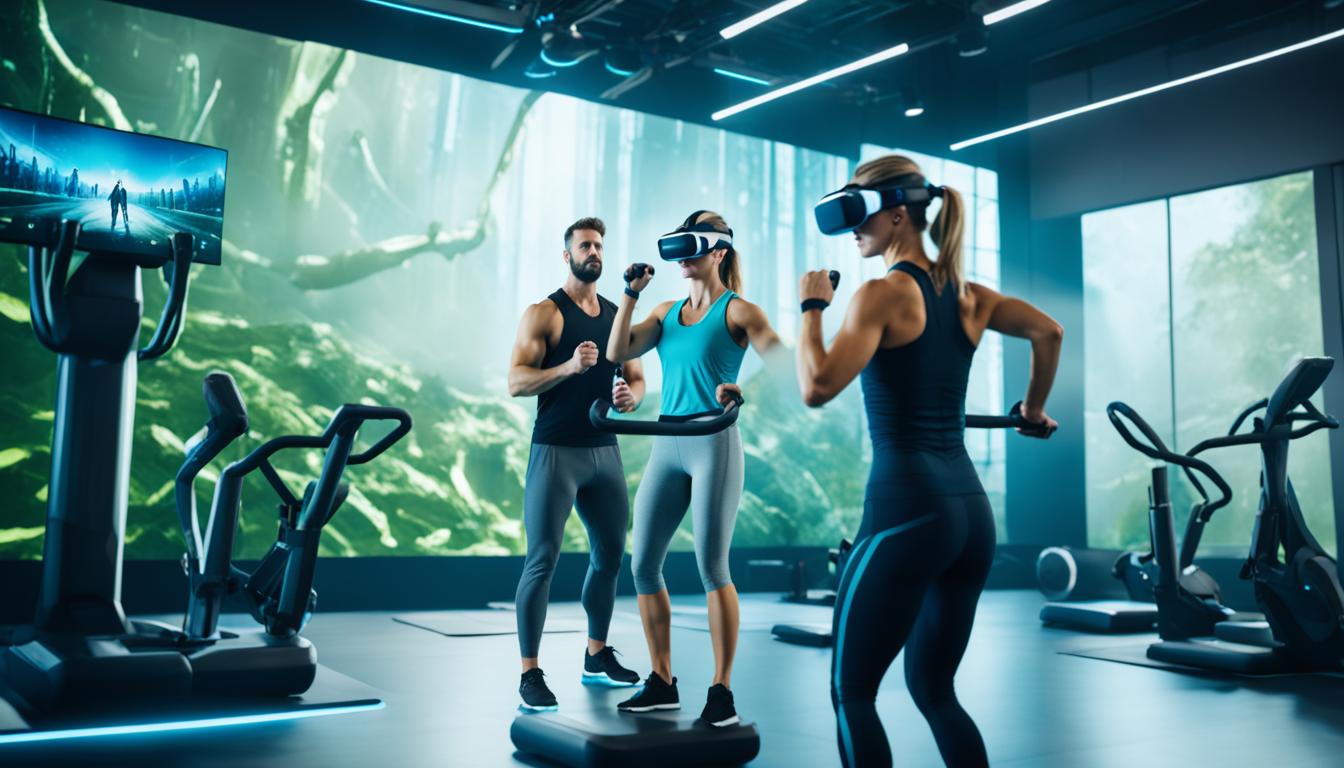Have you ever wondered how a refrigerator could order groceries for you? Or how a wearable device can track your health and fitness? The answer lies in the Internet of Things (IoT). This groundbreaking technology is revolutionizing the way we live, work, and interact with the world around us.
But what exactly is the Internet of Things, and how does it work? How can IoT devices and solutions enhance our daily lives, improve efficiency, and create a more connected future? Join us as we delve into the world of IoT and uncover its endless possibilities.
Key Takeaways:
- The Internet of Things connects physical objects with sensors, software, and other technologies, enabling them to collect and exchange data.
- IoT devices range from household appliances and wearables to industrial machinery and smart city infrastructures.
- IoT offers advantages such as increased efficiency, improved healthcare, enhanced safety and security, and environmental impact.
- Challenges in the IoT landscape include security and privacy concerns, interoperability issues, data overload, and regulatory considerations.
- The future of IoT is promising, with advancements in technology shaping a smarter and more interconnected world.
Understanding IoT: A Web of Connected Devices
In its essence, the Internet of Things refers to the vast network of physical objects embedded with sensors, software, and other technologies that enable them to collect and exchange data over the internet. These “smart” devices can range from household appliances, wearable fitness trackers, and smart thermostats to industrial machinery, autonomous vehicles, and entire smart cities’ infrastructures. At the core of IoT lies the ability of these devices to communicate with each other and with centralized systems through the internet. This two-way data exchange enables real-time monitoring, analysis, and control of connected objects, leading to enhanced automation, insights, and decision-making.
IoT applications have revolutionized various industries and sectors, from healthcare and transportation to agriculture and manufacturing. Understanding the power of connected devices is essential in navigating the ever-expanding IoT landscape. Whether it’s seamlessly managing your home’s energy consumption, monitoring your health and fitness goals, or optimizing industrial processes for increased efficiency, IoT offers endless possibilities for improving our lives and businesses.
Real-World Examples of IoT
Below is a table highlighting some real-world examples of IoT applications:
| Industry | IoT Application | Benefits |
|---|---|---|
| Healthcare | Remote patient monitoring | Improved patient care, early detection of health issues |
| Agriculture | Smart irrigation systems | Water conservation, optimized crop yield |
| Transportation | Connected vehicles | Enhanced safety, reduced traffic congestion |
| Manufacturing | Industrial automation | Increased efficiency, reduced operational costs |
These examples demonstrate the transformative power of IoT in various sectors. By harnessing the capabilities of connected devices, businesses and individuals can unlock new possibilities for efficiency, sustainability, and growth.
“The Internet of Things will continue to revolutionize industries and reshape the way we live and work. It’s an exciting time to be part of the connected era!”
Real World Examples of IoT
IoT technology has permeated various industries, leading to innovative applications that enhance efficiency, convenience, and sustainability. Let’s take a closer look at some real-world examples of IoT in action:
1. Urban Footprint: Designing Sustainable Cities
Urban Footprint is a company that uses IoT technology to design and develop sustainable cities. By leveraging connected sensors, data analytics, and advanced algorithms, Urban Footprint enables urban planners to evaluate energy usage, optimize resource allocation, and create more environmentally friendly communities. Through IoT-powered systems, cities can monitor energy consumption, reduce waste, and enhance overall sustainability.
2. AI Home Solutions: Empowering Smart Homes
AI Home Solutions is a leading provider of consultation and installation services for homeowners looking to integrate IoT technology into their homes. From smart thermostats that adjust temperature based on occupancy to connected security systems that offer remote monitoring, AI Home Solutions enables homeowners to create intelligent, automated living environments. By leveraging IoT devices and platforms, individuals can enhance comfort, convenience, and security within their homes.
3. Samsung Electronics’ Smart Appliances
Samsung Electronics utilizes IoT technology to power their line of Smart Appliances. These connected devices, such as refrigerators, washers, and air conditioners, can communicate with each other and with users through smartphone apps. For example, a Samsung Smart Fridge can provide real-time updates on inventory, suggest recipes based on available ingredients, and even place grocery orders. By combining IoT technology with everyday appliances, Samsung Electronics offers enhanced convenience and efficiency to users.
These examples highlight the diverse applications of IoT technology in the real world. From sustainable urban planning to smart home solutions and connected appliances, IoT continues to reshape industries and our daily lives. As technology advances, we can expect even more innovative and impactful use cases for IoT, driving us towards a more connected and efficient future.
The Advantages of IoT: Creating a Smarter World
IoT brings numerous advantages to various industries and sectors. Let’s explore some of the key benefits:
1. Increased Efficiency
Through IoT, businesses can optimize their processes, leading to increased efficiency and productivity. IoT devices enable automation, real-time monitoring, and data-driven decision-making, resulting in streamlined operations and reduced costs. This improved efficiency allows organizations to allocate resources more effectively and achieve higher levels of productivity.
2. Improved Healthcare
IoT is transforming the healthcare industry by improving patient care and outcomes. Connected devices and wearables can monitor patients’ vital signs, track medications, and collect real-time health data. This information can be shared with healthcare professionals remotely, enabling early detection of health issues, personalized treatment plans, and more efficient healthcare delivery.
3. Enhanced Safety and Security
IoT-powered systems are revolutionizing safety and security measures. Smart home security systems, for example, utilize IoT technology to integrate surveillance cameras, motion detectors, and alarms, enabling homeowners to monitor and control their homes remotely. In industrial settings, IoT-enabled sensors can detect potential hazards, ensuring the safety of workers and preventing accidents.
4. Transportation and Mobility
IoT is reshaping transportation and mobility systems, leading to improved efficiency and reduced congestion. Smart transportation systems can optimize routes, manage traffic signals, and provide real-time updates to travelers, enhancing the overall transportation experience. Autonomous vehicles, enabled by IoT technology, hold the potential to revolutionize the way people and goods are transported, making transportation safer and more convenient.
5. Environmental Impact
IoT has the potential to positively impact the environment by enabling smarter resource management and environmental monitoring. Connected sensors can monitor air quality, water usage, and energy consumption, allowing for more accurate analysis and optimized utilization of resources. IoT also aids in predicting and mitigating natural disasters, facilitating proactive measures to protect the environment and human lives.
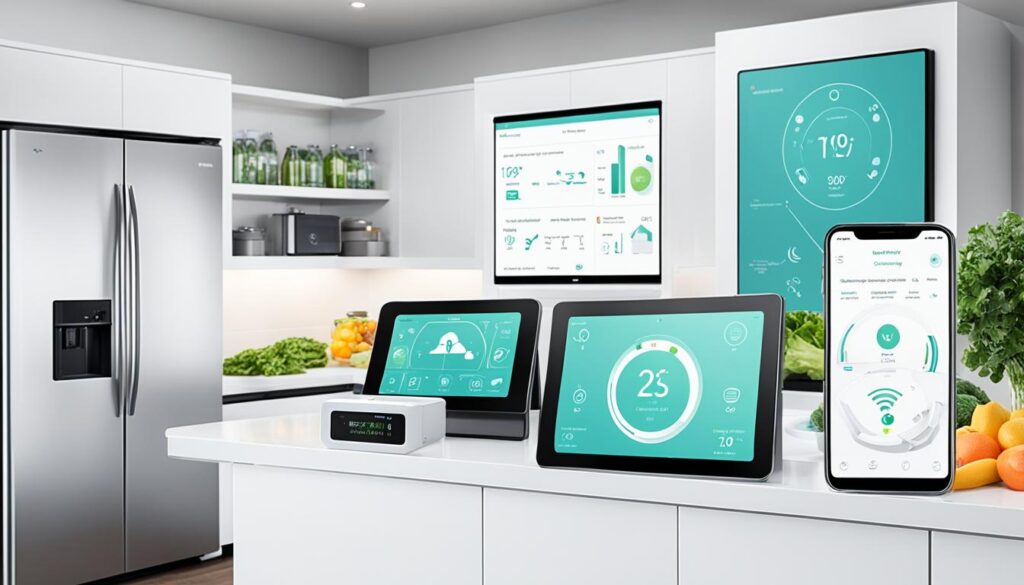
“IoT brings numerous advantages to various industries and sectors. Increased efficiency, improved healthcare, enhanced safety and security, improved transportation and mobility, and environmental impact are just a few of the benefits that IoT offers.”
With the myriad of advantages that IoT brings, it’s clear that this technology has the potential to revolutionize the way we live, work, and interact with the world around us. The possibilities that IoT presents are vast, and as we continue to embrace this connected era, we can create a smarter, more efficient, and sustainable world for future generations.
Challenges and Concerns: Addressing the IoT Landscape
While the Internet of Things (IoT) holds great promise, it also presents a set of unique challenges that need to be addressed. These challenges encompass various aspects, including security and privacy, interoperability, data overload and analysis, as well as regulatory and ethical considerations.
Security and Privacy
Securing the vast network of interconnected devices is a critical concern in the IoT landscape. The potential for security breaches and data privacy violations poses significant risks to individuals, organizations, and even entire industries. Safeguarding sensitive information and protecting user privacy demand robust security measures and protocols. Implementing encryption, authentication mechanisms, and access controls are essential steps towards enhancing IoT security.
Interoperability
The lack of standardized communication protocols among different IoT devices and platforms presents a significant challenge. Interoperability issues hinder seamless communication and interoperability between devices, hindering the realization of IoT’s full potential. Establishing universal standards and protocols is key to ensuring compatibility and effective interconnectivity among diverse IoT devices and systems.
Data Overload and Analysis
The sheer volume of data generated by IoT devices can overwhelm organizations, leading to data overload and analysis challenges. Effectively managing and analyzing the massive amounts of data generated is crucial to extract meaningful insights and drive informed decision-making. Leveraging advanced data analytics tools and techniques is essential for organizations to navigate the data deluge and derive actionable intelligence.
Regulatory and Ethical Considerations
As IoT continues to expand and become more integrated into our daily lives, it raises important regulatory and ethical considerations. Ensuring responsible deployment and usage of IoT technology requires established regulations and ethical frameworks. Striking a balance between innovation and protecting user rights and privacy is crucial in creating a trustworthy and sustainable IoT landscape.
To address these challenges, collaboration and cooperation among industry stakeholders, policymakers, and technology experts are paramount. By acknowledging and actively working towards mitigating these challenges, we can unleash the full potential of IoT and propel society towards a smarter, more connected future.
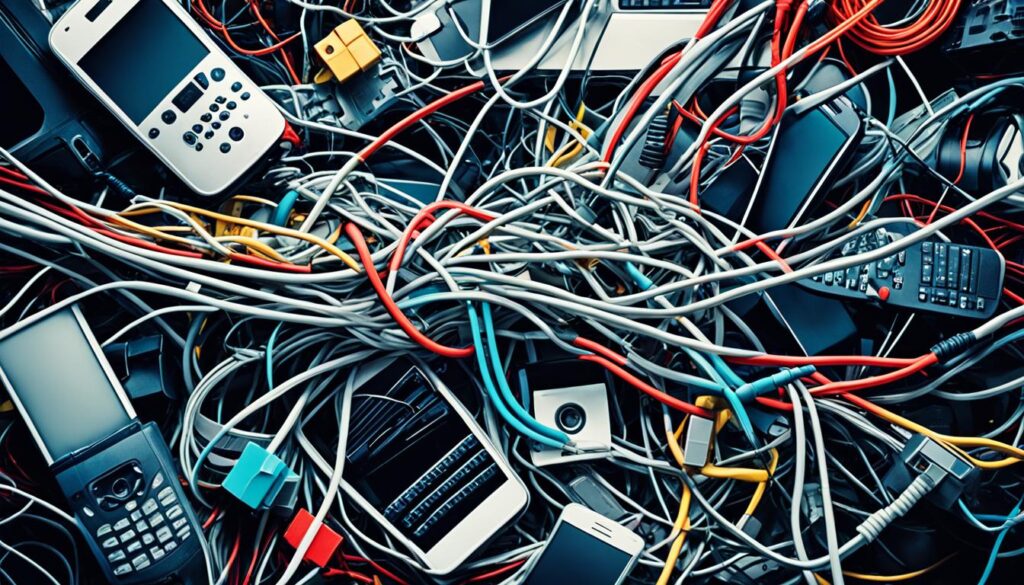
Conclusion
The future of IoT is incredibly bright and holds great promise for transforming industries and society as we know it. As technology continues to advance at an unprecedented pace, the applications of IoT will become even more sophisticated and diverse, paving the way for a connected era like never before.
However, navigating the complexities of IoT and ensuring its success requires collaboration among various stakeholders. Governments, businesses, researchers, and consumers must work together to address challenges such as security, privacy, interoperability, and ethical considerations. By doing so, we can create a secure and interconnected IoT landscape that brings immense benefits to all.
Embracing the connected era means taking responsibility for how we deploy and use IoT technology. It means being proactive in implementing robust security measures, protecting user data, and adhering to ethical standards. It means leveraging IoT’s potential to shape a smarter, more efficient, and sustainable world for future generations.
The future belongs to those who embrace the opportunities brought by IoT and are committed to harnessing its true potential. Together, let us unlock the transformative power of IoT and embark on a journey towards a future where connectivity and innovation thrive.
